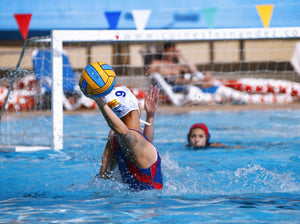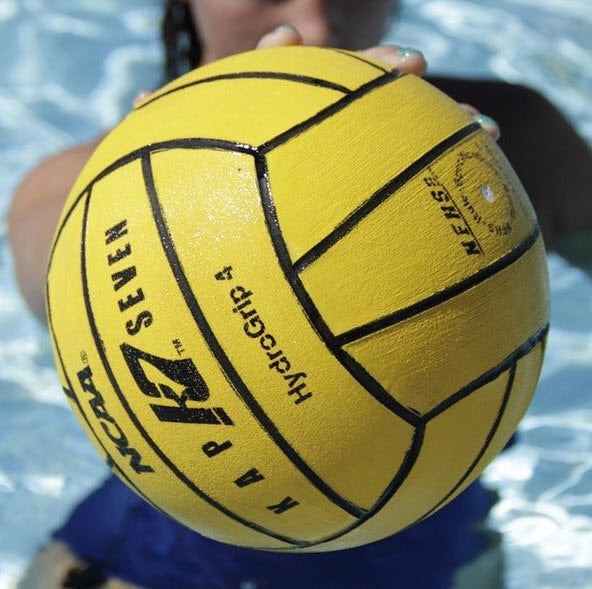Dryland Leg Strength Drills for Water Polo
 Your legs will get plenty of exercise during water polo practice, but adding a dryland element to your workout routines gives you a chance to target specific muscles and skills that are difficult to develop in the water.
Your legs will get plenty of exercise during water polo practice, but adding a dryland element to your workout routines gives you a chance to target specific muscles and skills that are difficult to develop in the water.
Since water polo players have a tendency to over-train certain areas (strong chests and arms, weak backs and cores), dryland training is the perfect time to address these weaker muscle groups. This guide includes a variety of dryland leg strength drills beneficial to water polo players.
When doing dryland exercises, make sure that you are wearing closed-toe athletic shoes. If you are exercising outside and in the heat, wear sun block and have a water bottle with you at all times to prevent dehydration and heat stroke. Comfortable tops and bottoms made of breathable fabric are also important as they provide full range of motion as you move in new ways.
Lunges
Lunges develop your thigh muscles and improve hip mobility — both of which are very important for treading. There are several lunge variations; a few more common examples are outlined below.
- Forward Lunges: Start with your feet hip-width apart. Take a long step forward with one leg. Drop down until the knee of your back leg lightly touches the ground. Rise up and push back to standing position. Keep your hands on your hips and your torso upright. Repeat with your other leg.
- Backward Lunges: Keeping your hands on your hips and your torso upright, take a large step backwards. Drop down until the knee of your back leg lightly touches the ground. Ride up and step forward, back to your original standing position. Repeat with your other leg.
- Side Lunges: Start with your feet hip-width apart. With your right leg, take a long step to one side. Keeping your head looking up and your back flat, bend your right leg and touch your fingertips to the ground. They should touch down near your instep. Ride up and step your feet back together, then repeat with your left leg.
Step it Up
Initially, try to do two to three rounds of 10 repetitions. If you want to make regular lunges more difficult, jump up and switch legs while you're in the air. Land softly and don't let your torso fall forward. Drop down, and then jump up to switch again. You can also hold weights at your sides (with or without jumping) to make any style of lunges more difficult.
Jumps
Do jumps on flat surfaces like pool decks or gyms, where the chance of landing on an unexpected object and injuring your ankle is small.
Dryland jumps provide a great way to increase your explosive power in the water. There is hardly a better -- or faster -- way to get your thigh muscles burning than with a jump set. Try to do two to three rounds of 10 repetitions.
Basic Jumps
Stand with your legs hip-width apart. Bend down until your legs are comfortably bent, but don’t go too far; you don't want to spend time unwinding your legs before you're able to leave the ground. Explode upwards as high as possible, bringing your knees to your chest. Land softly and bend your knees to get ready for another jump right away. Use your arms to help you get height.
Medicine Ball Jumps
Hold a medicine ball at your chest with both hands, elbows out. Squat down as low as you would for a normal jump. As you jump up, push the ball up off your chest and up into the air as high as possible. Make sure you have plenty of room for this drill and that everyone participating is facing the same direction so that the balls all land far away from the group.
Box Jumps
Face a box, step, or any other solid platform that’s at least several inches off the ground. Jump up with both legs and land with your knees bent. Jump backwards off the platform. You can also do a more stable variation of this drill by stepping up with one leg at a time, and then driving the other leg up to your chest. If you use this approach, be sure to alternate legs.
Squats
To make squatting more challenging, you can hold a weight between your legs or at your chest, or incorporate a jump as you stand up after each squat.
Squats are one of the best all-around leg exercises. They engage multiple muscles when performed correctly, and are also one of the highest calorie-burning exercises per move. Starting with your legs a little wider than hip-width apart, squat down until your legs bend about 90 degrees. Stand up and repeat. Keep your torso upright and your shoulders back for the whole move.
Wall Sits
Sit with your back against a wall so that your thighs are parallel to the ground. There should be a 90 degree angle between your shins and your thighs. Keeping your knees close, hold this position for a set amount of time (30 seconds is a good place to start out). For an extra challenge, squeeze a small ball between your knees. Don't use your arms to brace yourself against your legs, and keep your chest and head up the entire time.
Most of these drills (if performed properly) also help strengthen your back and core. Keeping your shoulders back and chest up will ensure your core abdominal muscles engaged — think about pulling your belly button towards your spine to keep them working hard the whole time.
Sprints, Skips & Stairs
Sprints
On a field, gym floor or stretch of flat ground, mark off lines a few hundred feet apart. At a signal from a coach or teammate, sprint to the other end. If multiple players run at once, make it a race.
Sprints can be made extra challenging with the addition of resistance. Wrap a large elastic band around two players; one will sprint against the band to the finish line while the second leans back and does their best to slow them down. Pulling weighted sleds offers a similar benefit.
Skips
Instead of straight running sprints between lines, players can also skip or side shuffle. This works different calf, thigh and hip muscles for a stronger overall leg and improved balance.
Stairs
Running up and down sets of stairs, either in a stadium or elsewhere, is also an excellent cardio and conditioning workout. To give the legs a break, your coach can add sets of pushups, abdominal workout or stretching at the top and bottom.
The Best Way to Add Dryland
Adding a dryland element to your water polo training repertoire can be incredibly beneficial, but it should also be done prudently. You should remember that it is easier to injure yourself out of the water, so having coaches and teammates constantly monitoring players’ forms makes for a much safer exercise environment.
Dryland should also be a supplement to, not a replacement for, time in the water. Many teams prefer to do their most strenuous dryland practices in the off-season, or just during the beginning of the season when conditioning is most important. Once your season is in full swing, consider reducing the time spent on dryland training — using it more for maintenance may help you prevent injuries.



